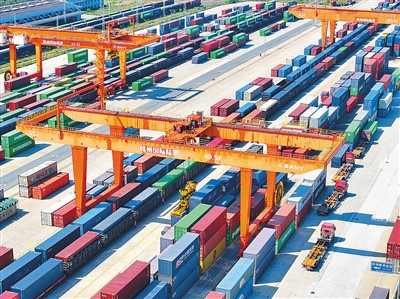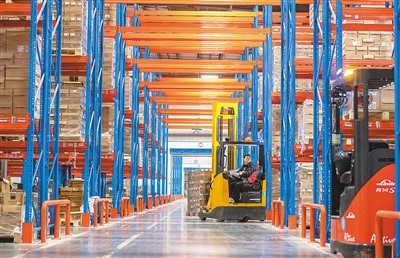Eight keywords mirror a more open China in 2023
In 2023, China has made significant strides in advancing high-level opening-up, achieving notable progress in institutional opening-up, and continuously enhancing its trade structure. These efforts have injected momentum into fostering mutual benefit and win-win cooperation globally.
The following eight keywords highlight China's measures and accomplishments in its broader opening-up initiatives in 2023.

Containers of exported new energy vehicles are handled by gantry cranes at an international land port in Ganzhou, east China's Jiangxi Province. (Photo/Zhu Haipeng)
Exhibition
Data from China's Ministry of Commerce shows that in the first nine months of this year, 3,248 exhibitions were held in specialized venues nationwide. This represents a significant increase of 1.8 times compared to last year and a 32.4 percent increase from the same period in 2019.
Out of these, 1,908 were major exhibitions, which is more than double (a 2.3-fold increase) from 2022 and a 56.9 percent increase from 2019. The total area used for these exhibitions reached 76.86 million square meters, marking a 1.7-fold increase year on year and a 51.5 percent increase from the same period in 2019.

An exhibitor presents Ethiopian coffee during the third China-Africa Economic and Trade Expo in Changsha, central China's Hunan Province. (Xinhua/Sun Ruibo)
This year, the 134th China Import and Export Fair, also known as the Canton Fair, recorded offline export deals totaling $22.3 billion. The 2023 China International Fair for Trade in Services, the world's largest services trade fair, yielded more than 1,100 outcomes, with international enterprises accounting for over 20 percent of all enterprises attending offline. The 6th China International Import Expo saw tentative deals worth $78.41 billion signed, 6.7 percent higher than the previous expo.
China has received widespread acclaim for accelerating the creation of a matrix of world-class exhibitions. "As China has proven, opening up is not just about removing trade barriers or encouraging investment; it is about opening minds to new ideas and hearts to cultural exchange," said Rebeca Grynspan, Secretary-General of the United Nations Conference on Trade and Development.
Manufacturing sector
China announced the removal of all restrictions on foreign investment access in the manufacturing sector at the third Belt and Road Forum for International Cooperation (BRF), which commenced on Oct. 18, 2023.
"This move demonstrates China's commitment to high-standard opening-up. It is also a crucial step towards establishing a new, higher-standard open economy system," stated Li Dawei, director of the Emerging Economies Research Office under the Institute of International Economic Research of the Chinese Academy of Macroeconomic Research.
With this change, China has fully opened its general manufacturing sector to foreign investment. In pilot free trade zones (FTZs), restrictions on foreign investors in manufacturing have been eliminated from the negative list. Furthermore, restrictions on foreign automakers' access to the Chinese market have been lifted since 2022.
During the first 10 months of this year, foreign direct investment (FDI) in manufacturing in China rose year on year to 283.4 billion yuan ($39.7 billion). Notably, FDI in high-tech manufacturing logged a 9.5 percent increase. Specifically, the medical equipment and instrument manufacturing sector saw a 34.6 percent year-on-year increase in FDI, while the electronic and communication equipment manufacturing sector experienced 14.8 percent growth compared to the same period last year.
Service sector
Since 2015, China has authorized 11 provinces and cities to initiate comprehensive pilot programs to open up the service sector. In the first three quarters of 2023, the added value of the service industry in these areas reached 13.2 trillion yuan, accounting for 69.7 percent of their regional GDP. During the same period, FDI in the service sector in these provinces and cities stood at $50.85 billion, representing 55.6 percent of the national total.
In November 2023, China's State Council approved a plan to support Beijing in developing a comprehensive demonstration zone for expanding and opening up the service sector. This plan aims to promote reform and opening-up in key areas of the service sector, advance the formation of rules and regulations for new business models in the sector, and optimize trade and investment institutional arrangements.
Belt and Road Initiative
This year marked the 10th anniversary of the Belt and Road Initiative (BRI). The initiative has evolved into the most widely embraced international public good and the largest platform for international cooperation. Over the past decade, the BRI has yielded tangible and significant outcomes.

Passengers pose for photos with a high-speed electrical multiple unit (EMU) train at the platform of Tegalluar Station on the Jakarta-Bandung High-Speed Railway in Bandung, Indonesia. The railway, jointly built by China and Indonesia, officially began commercial operation Oct. 17, 2023. (Xinhua/Xu Qin)
Data indicates that Chinese enterprises have created 421,000 jobs in economic and trade cooperation zones within BRI participating countries. Belt and Road cooperation is projected to help lift 7.6 million people out of extreme poverty and 32 million out of moderate poverty worldwide by 2030.
The China-Europe freight train service has emerged as a flagship project and a hallmark brand under the BRI. To date, approximately 81,000 China-Europe freight train trips have been made, serving 217 cities in 25 European countries. This service has played a crucial role in maintaining the stability of global industrial and supply chains, providing a significant boost to global economic development.
Moreover, more than half of the 369 cooperation initiatives agreed upon at the third BRF have already been implemented.
FTZs
This year marks the 10th anniversary of the establishment of China's first FTZ in Shanghai.
Over the past decade, the China (Shanghai) Pilot Free Trade Zone, or Shanghai FTZ, has seen the registration of 84,000 new enterprises and more than 14,000 new foreign-funded projects. The total amount of foreign investment in this zone has reached $58.6 billion.

A photo taken Nov. 11, 2023, shows the unveiling ceremony of the Kashgar Area of the China (Xinjiang) Pilot Free Trade Zone in Kashgar, northwest China's Xinjiang Uygur Autonomous Region. (Xinhua/Ding Lei)
China has established 22 pilot FTZs. The Kashgar Area of the China (Xinjiang) Pilot Free Trade Zone in Kashgar, in northwest China's Xinjiang Uygur Autonomous Region, was unveiled on Nov. 11, 2023. The first batch of 35 enterprises settled in with contracted project funds of more than 17.6 billion yuan. These enterprises span various fields, including trade and logistics, electronics and information, new materials, and automotive parts processing.
Although covering less than 0.004 percent of the country's land area, the 21 FTZs attracted 18.4 percent of China's foreign investment and accounted for 18.6 percent of the country's foreign investment in the first half of 2023.
New "three major ones"
New energy vehicles (NEVs), lithium-ion batteries, and photovoltaic (PV) products have overtaken apparel, home appliances, and furniture as the new "three major ones" driving China's exports.
In the first three quarters of 2023, China's total exports of electric vehicles, lithium-ion batteries, and solar batteries rose by 41.7 percent year on year.
China has led the world in NEV production and sales for eight consecutive years, now holding more than 60 percent of the global market share.
From January to September 2023, China's cumulative exports of lithium-ion batteries reached $48.6 billion, marking a year-on-year increase of over 30 percent. The country has also maintained its global leadership in PV module output for 16 consecutive years.
Digital trade
Digital trade is emerging as a new trend in global trade development and will be a new growth point of international trade in the future, according to Vice Commerce Minister Wang Shouwen.
In the first eight months of this year, China's digitally-delivered service trade increased by 10.4 percent year on year to 1.81 trillion yuan. From January to September 2023, the import and export volume of cross-border e-commerce totaled 1.7 trillion yuan, expanding 14.4 percent year on year and accounting for 5.5 percent of the trade volume in goods during the same period.

A worker delivers a forklift to transport cross-border e-commerce goods in Jinyi Comprehensive Bonded Zone, Jinhua, east China's Zhejiang Province, during the "Double 11" shopping spree in 2023. (Photo/Shi Kuanbing)
The integration of digital technology with the real economy has energized new forms of consumption, including internet gaming, online education, and telemedicine, thus boosting the potential of China's digital trade.
Yuan internationalization
From January to August 2023, 58 panda bonds were issued, totaling 106 billion yuan. This represents a 58.2 percent increase year on year, surpassing both the total number and amount of issuances from the previous year.
The Chinese currency, the yuan, also known as the renminbi (RMB), reached a record high in its share of global payments in September 2023, climbing to 5.8 percent from 3.9 percent at the beginning of the year. This increase placed the yuan ahead of the euro for the first time, according to data from the Society for Worldwide Interbank Financial Telecommunication (SWIFT).
As of the end of September 2023, 1,110 foreign institutions had entered the Chinese bond market, holding 3.3 trillion yuan in Chinese bonds. This figure represents a nearly 200 percent increase compared to five years ago.
The People's Bank of China (PBOC), China's central bank, has authorized 31 yuan clearing banks in 29 countries and regions, covering major international financial centers.
In 2023, the yuan's role as an international currency was further enhanced. The 2023 RMB Internationalization Report released by the PBOC indicated that cross-border yuan business more effectively supported the real economy. The report also noted that the yuan's international role in financing had grown, and offshore yuan trading saw increased activity.
Photos
Related Stories
- U.S. business insiders find China's tourism market more attractive due to wider opening-up
- China strives to build higher-level open economy
- Organizing major exhibitions demonstrates China's commitment to opening up
- Zhejiang steps up efforts to build model of high-level opening up
- China to advance high-standard opening-up with more proactive efforts: FM
- Chinese vice president stresses promoting high-standard opening up
Copyright © 2023 People's Daily Online. All Rights Reserved.









